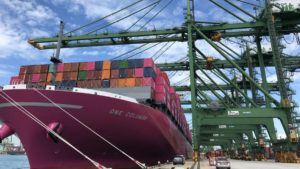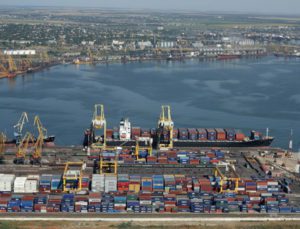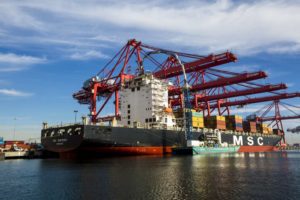
In January-April 2020, the seaports of Ukraine handled more than 55 million tonnes of cargo, which is 12.6% more compared to the same period in 2019.
According to the statement of the Ukrainian Sea Ports Authority on the state-owned enterprise’s website, traditionally, the leaders in transshipment are grain and ore.
Over the indicated period 18.7 million tonnes (5% more) of grain and 13.8 million tonnes of ore (30.5% more) were handled.
Handling of coal doubled to 2.5 million tonnes and that of crude oil increased by five times to 800,000 tonnes. Transshipment of containers by Ukrainian ports amounted to 357,700 TEU (up by 17.2%).
According to the Sea Ports Authority, handling of exported cargo increased due to a rise in transshipment of grain to 18.2 million tonnes (by 5.3%), iron ore to 10.9 million tonnes (by 45.4%), oil to 2.2 million tonnes (by 8.8%).
Transshipment of imported cargoes increased due to a rise in handling coal to 2.3 million tonnes (by 106.9%) and crude oil to 500,000 tonnes (by 213.6%), and oil products to 400,000 tonnes (by 233.3%).
Transit transportations increase due to a rise in handling ore to 1.1 million tonnes (by 34%) and crude oil to 400,000 tonnes.
Four seaports led in terms of cargo handling: Pivdenny, Mykolaiv, Chornomorsk and Odesa. In general, they processed 47.7 million tonnes of cargoes, which is 87% of the total volume of cargo handling by Ukrainian seaports.

Ukrainian seaports handled 13.5 million tonnes of cargo in January 2020, which is 20% more than a year ago. The press service of the Ukrainian Sea Ports Authority reported on Tuesday that the growth in cargo handling is linked to warm weather, exports of grain and ores and the large increase in imported coal handling.
According to the company, the first place in terms of transshipment volumes continues to be occupied by grain cargo, which in January 2020 shipped 4.7 million tonnes (a rise of 22%). Ore transshipment increased by almost a third (a rise of 32%) compared with the beginning of 2019, to 3.1 million tonnes.
In addition, during January 2020, record changes were seen in coal transshipment: in January of this year, 4.2 times more coal were handled – almost 771,000 tonnes. Positive dynamics is also continuing in the growth of container cargo, the amount of which increased by 15.8% and totaled 89,700 TEU.
In January 2020, 10.2 million tonnes were processed in the export direction, which is 1.5 million tonnes or 17% more than in the same period of 2019. Some 2.2 million tonnes of import cargoes were handled: 595,000 tonnes or 37% more, 965,000 tonnes of transit cargo: 210,000 tonnes or 28% more. Transshipment in domestic traffic in January 2020 increased 45% or by 29,000 tonnes and amounted to more than 93,000 tonnes. Mostly, grain and other bulk cargo and oil were transported between ports as coastal transportation.

The seaports of Ukraine in 2019 handled 160 million tonnes of cargo, which is 18.4% more than in 2018, the press service of the Ukrainian Sea Ports Authority has said.
“For the third year in a row, Ukraine’s seaports demonstrate an increase in transshipment. This year, our 13 ports, excluding those that remained in the territory of Crimea, have reached a record high in the entire history of their existence – 160 million tonnes. The maximum levels of grain and ore transshipment have been recorded. Container transportation overcame a ten-year maximum – one million TEU. Three ports at once, Pivdenny, Mykolaiv and Olvia, reached the maximum transshipment volume since their creation. And finally, the authority managed for the second time to provide dredging in the amount of more than 7 million cubic meters,” head of the agency Raivis Veckagans said.
According to the report, the agricultural sector carried out a record transshipment in 2019. Thus, according to the enterprise, grain cargo and oil accounted for more than a third (37.7%) of the total cargo flow in Ukrainian ports, while grain handling increased by 32%, to 54.6 million tonnes.
Transshipment of ore ranked second with 37.3 million tonnes per year (33% more). The top three cargo types in 2019 also included containers – more than 1 million TEU.
Exports rose by 22.2% compared with the same period of the previous year, to 121 million tonnes, imports by 8.7%, to 2.58 million tonnes, transit by 8%, to 11 million tonnes.
Among the Ukrainian ports, the leaders in terms of cargo transshipment in 2019 were Pivdenny with 53.9 million tonnes (26.1% more), Mykolaiv with 33.4 million tonnes (14.5% more), Chornomorsk with 26.2 million tonnes (21.4% more), and Odesa with 25.3 million tonnes (16.8% more).

The seaports of Ukraine in 2019 handled 1.003 million TEU containers, which is 18% more than in 2018.
The press service of the Ukrainian Sea Ports Authority said that the transshipment of containerized cargo in Ukraine is several times higher than the world’s average figure in the container shipping market.
“Now four private container terminals are successfully operating in Ukrainian ports, which are planning to develop their capacities in 2020. Corresponding memorandums and agreements were signed between the agency and the subsidiary of the German company HHLA, Container Terminal Odesa, as well as the world’s third largest container line СMA CGM together with the Ukrainian company Brooklyn-Kyiv,” head of the Ukrainian Sea Ports Authority Raivis Veckagans said.
According to him, this gives reason to count on the further development of container transportation, especially due to the transit of containers and the inclusion of Ukraine in the routes of the Chinese Silk Road and the transport corridor Europe-Caucasus-Asia (TRASECA), the first cargoes on which were delivered in 2019.
According to the agency, the export and import of containers in 2019 was distributed almost evenly with a slight advantage of imports – 48.6% and 46.8% respectively. At the same time, positive export dynamics is ensured by increasing the containerization of food and light industry products (processing of agricultural raw materials, including flour, wheat, peas; textile products). The strengthening of the hryvnia traditionally influences the growth of containerized cargo imports, which makes deliveries from abroad of food, machinery and electronics, construction materials and other goods more attractive.
Container cargo transit increased by 42% compared to 2018 and amounted to 46,400 TEU.

The seaports of Ukraine in January-October 2019 handled 129.8 million tonnes of cargo, which is 20.2% more compared to the same period in 2018. According to the press service of the Ukrainian Sea Ports Authority, the volume of grain and ore transshipment for the indicated period increased by more than a third.
At the same time, compared with the same period in 2018, the volume of grain transshipment grew by 37% (43.6 million tonnes), ore by 33% (30.5 million tonnes).
Transshipment of liquid cargo (oil, petroleum products, and others) rose by 9.6%, to 9.3 million tonnes.
In addition, according to data for January-October, the trend of container handling growth continues: in the ten months it increased by 19% (812,000 TEU).
The volume of exports increased by 24% compared with the same period of the previous year, imports by 12%, transit by 8%.
Among Ukrainian ports, five ports became the leaders in transshipment in the ten months, which provided the processing of more than 90% of the total cargo volume.
Over the ten months, the sea ports of Ukraine handled 9,800 ships, and increased the volume by 2.1% from last year’s figure.

Ukraine’s seaports, whose share in import deliveries of diesel fuel is rapidly growing amid the introduction of duties on Russian resources supplied by pipeline, will have to accept a record volume of diesel fuel in the amount of 150,000 tonnes in October, director of A-95 Consulting Group (Kyiv) Serhiy Kuyun said on Facebook.
According to him, to date, the record volume fixed in the autumn of 2015 was 130,000 tonnes.
Kuyun said that in September the share of seaports in the structure of import deliveries was 20%, whereas a year earlier it was 10%. The share of fuel supplies from Belarus is 53% (against 36% in September 2018), Russian deliveries by rail 6% (against 3%), Russian deliveries through Gomel 12% (against 9%), and Lithuania’s share some 9% (against 8%).
“After the tense first half of September, when the price of diesel fuel increased by more than 11% due to deficit, the market was balanced by the end of the month even with a slight surplus. It will come in handy in October, when supplies from Belarus are expected to fall due to the halt of Mozyr oil refinery,” the expert said.
The required amount of fuel, he said, will be covered by increasing supplies through seaports, oil refining by Ukrtatnafta, and railway deliveries from Russia.
Commenting on the market price situation in September, he noted that the cost of diesel fuel is not yet striving to decrease.